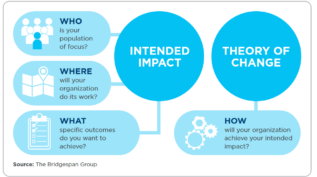
A theory of change describes a process of planned social change, from the assumptions that guide its design to the long-term goals it seeks to achieve. Grant makers who have created theories of change explain that having a theory helps them and their grantees draw logical connections between activities and outcomes. It helps them to articulate exactly what propositions and assumptions their work is testing — and therefore what they should be assessing in their evaluation plan.
This Content Collection features guides and examples for family foundations and others seeking to create a Theory of Change for their philanthropic strategies.
Please see the NCFP Content Collections on Systems Change and Strategic Philanthropy for related information and resources.
Start Here


Theory of Change, Monitoring, and Evaluation: Understanding an Organization’s Activities, Outcomes, and Impact
Tool
